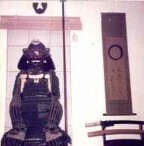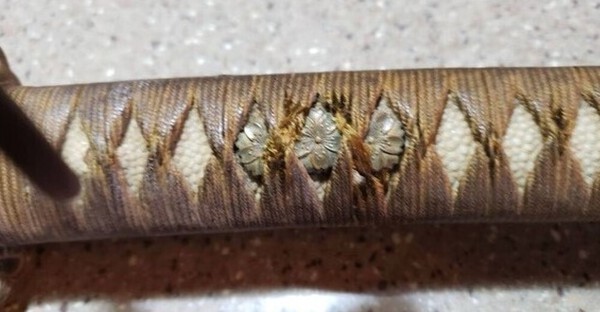-
Posts
930 -
Joined
-
Last visited
-
Days Won
8
Everything posted by The Blacksmith
-

What exactly do I have? I'm stumped!
The Blacksmith replied to Onigoroshi's topic in General Nihonto Related Discussion
It looks to me like the hamon has been acid etched to give the appearance of an actual hamon. -

shirasaya question and patterns in the hamon
The Blacksmith replied to ysake's topic in General Nihonto Related Discussion
When I make knives I often use black buffalo horn, and when polished it can look very much like plastic. but it feels slightly different. It should have a slightly white grain in the horn, which plastic doesn't have. The inside of the mounts should tell you more. Horn is quite cheap, so I doubt that they would use any kind of plastic. -
Yes, but the added expenditure on antiques and associated items doesn't bear thinking about! I couldn't imaginw walking round an antiques market or Sunday market in Japan! Incidentaly, I understand that swords are licensed in Japan, does one have a collectors license, or is each blade individually licensed?
-
I personally, would most definitely repair it, and have done so in the past on a couple of wakizashi that I have had that had suffered similar damage. A fairly common occurrance unfortunately. If it is within your skill set, then fine, otherwise leave well alone I think is the rule. Everybody of course has their own parameters of what is desirable/acceptable. This could be done and be totally invisible when finished, so why not.
-
Congratulations Brian, nice find, though I am still smarting at $30 for the two drinks! I thought Norway was expensive! But the tanto (should this really be termed an aikuchi ?), is a really nice find. It will be fun restoring the bits that need it, and will be very interesting to see when you have finished. Please post it when ytou have done it. Nice find, well done.
-

Name of these horimono?
The Blacksmith replied to Ilovekatana's topic in General Nihonto Related Discussion
The lower one perhaps was Daitoku Myo ? -
30" tall (2' 6") , so yes about the size of a large table lamp Brian. It is a beautiful little armour.
-
It may be possible to source a new tsuka (handle) for this via the forum. It would certainly be worth a try.
-
Black rust, is rust that forms with low oxygen levels, and without the moisture levels needed for red rust. It is relatively stable, but it is still rust, and thus something that you do not want anywhere near a Japanese sword blade.
-

Is this real or fake and what is the translation.
The Blacksmith replied to Ali's topic in Translation Assistance
In my very rusty kanji, I'd say it reads Kanesada, but if it is, then the Sada is poorly written. -

Genuine or not? Thoughts?
The Blacksmith replied to aabderson's topic in General Nihonto Related Discussion
If it helps any, here are the cropped and enlarged images that Alex posted.... Certainly looks Ok. I look forward to seeing images of the blade. -

Books, books ....... and more books
The Blacksmith replied to a topic in General Nihonto Related Discussion
Obviously in this respect, a man after my own heart! Great selection! You can never have too many that is certain. I catalogued my arms and armour book collection, which was a great surprise, and a fun thing to do, and once done it is so easy to update when a new tome is added. Just a thought. -
I do not recall either a Sho stamp or a Seki stamp. though it was without doubt a high quality gendaito, presumably made in an earler style for whatever reason. Of the two that I owned personally at the time, one as i mentioned was rather heavy and rather uninteresting, but the other which I think I may have pictures of was a beauty. Typical Seki WWII sugata, but with slight sunagashi in places, and several tobiyaki in the jigane, with yakidashi. This blade I think may most likely have been made by Kanezane personally. However, both had the kokuin.
-
When I had a small collection of armour, I got to know John Anderson who advised me on the restoration process, and he told me to clean laquer with a cotton bud and meths (rød sprit Sten!). It worked very well, and of course the meths simply evaporated off.
-
Thankyou Oliver, that's him! One of the blades that I had was a real stunner, and may well have been made by the man himself. The other one, though mounted in a sword with the Sakai mon, was clearly not of the same quality, and was very heavy in comparison. Bruce, similar to the one on the left, but even more cursive. It was actually quite difficult to read until one actually knew what it said, thanks to the Zane stamp. The shape of the nakago on the two that you show are quite different in shape to mine, or the one in question. A little more tapered than the one on the right, but not as tapered as that on the left, though perhaps, that is the slightly different nagle that it was photographed at that makes it appear more tapered. Thank you gents.
-
I mentioned in another post about a sword that I examined some years ago, which was signed Asano Kanezane. The blade, at first glance, appeared to be shinto, but when I read the mei, it was in fact dated November 1944! The actual mei was written in cursive kanji, looking like it was hand written , and it would have been difficult to read but for the hot stamp Zane kanji stamped in the end of the nakago. The hamon as I recall was notare, and the steel had a very white colour to it. I wondered if anybody has come across such a blade signed by Kanezane in this style before? I had two other swords at the time signed Kanezane, very different in style and quality, though I have read somewhere that some of his students occassionally signed his name on blades, which would partly account for the quality difference. The blade in question above, was an absolute beauty, and I had wondered if it was perhaps originally made as an offering, which again might account for the rather unusual style of the blade at such a late date. Any thoughts would be gratefully received. Unfortunately I do not have pictures of this blade.
-
Is it only the length that makes you think that it possibly isn't the original scabbard Brian?
-
Its not macramé that you thinking of is it Stephen? Because this isn't macramé.
-

Can this sword still be saved?
The Blacksmith replied to MartinAle's topic in Military Swords of Japan
I wouldn't let a togishi, trained or not, loose on this blade to be honest. These swords were totally machine made, so this blade could easily be gently machine polished without any real danger of damaging anything. Alternatively, I think that rough wire wool and Solvol Autosol (chrome polish), would work equally well here, and that is probably what I would use. Though I do have a machine polisher, the wire wool approach would preserve a little of the age patina here, which on this sword may not be inappropriate I feel. I must stress what Brian has already stated, that this type of sword, and ONLY this type of katana that could be treated this way! -

Help with Gunto translation
The Blacksmith replied to AirborneA152's topic in Translation Assistance
Thank you Bruce. For a moment I though the old grey matter had totally screwed up....again! -

Can this sword still be saved?
The Blacksmith replied to MartinAle's topic in Military Swords of Japan
Certainly salvageable! It is never going to be Juyo status, but it should clean up reasonably Ok. The saya is probably the worst bit, but a good soak in oil and a fine wire brush should show what we have left here. I would imagine that it will require new wooden inserts in the saya, but there again, given the relative good condition of the blade, maybe not. Personally, I would try and remove the tsuka. As Stephen has said, it will not have mei or anything on the nakago, so no point in taking it off for this reason, but if the sword is stripped, it will be much easier to get a more desirable finish on the fittings. Make sure that the screw is well oiled and that it has soaked in before trying to remove it, and quite possibly apply a hot iron bar to the screw before trying to loosen it. The hot bar wil cause the nut to expand a bit, and may loosen it slightly. This is always worth a try first before trying to unscrew a rusted bolt like this! Make sure that the locking catch is also well oiled, and that the oil has thoroughly penetrated before attempting to move the catch. otherwise you risk having it perhaps break right off! This would be a fun project to do, but it will never be a national treasure.










